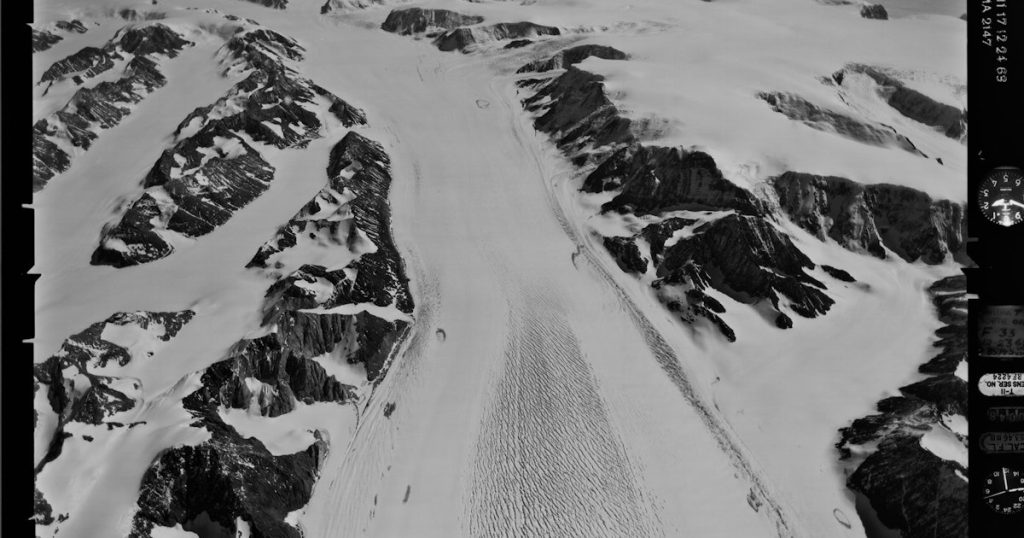In March 2002, the Larsen B ice shelf collapsed catastrophically, destroying an area roughly one-sixth the size of Tasmania.
In a paper published today, Scientific ReportsUsing nearly 1,000 film images of Antarctica from the 1960s, we accurately reconstructed what five glaciers looked like decades before the Larsen B ice shelf collapsed, allowing us to precisely calculate the glaciers’ contribution to sea-level rise.
Antarctica is remote, and environmental changes there may seem far away, but they could have a major impact on all of us. Ice shelf removal Glaciers could melt rapidly into the ocean, causing global sea levels to rise.
After years of unusually warm temperatures, the Larsen B Ice Shelf collapsed in a week, causing dramatic changes to the glaciers that fed into it. The glacier has been monitored extensively since then, but had received few observations prior to 2002.
But the archive of more than 300,000 historical images contains a rare record of the area in 1968, helping to gauge the differences between then and now.
The collapse of the Larsen B ice shelf seen from space on March 17, 2002.
National Aeronautics and Space Administration (NASA)
Glacier Observation
Ice shelves are thick bodies of floating ice attached to the Antarctic coastline. Their melting does not directly cause sea level rise.
However, ice shelves “block” the flow of glaciers: without them, the glaciers would melt rapidly into the ocean, causing land ice to move into the ocean and causing sea levels to rise.
To accurately predict how Antarctic glaciers will respond to future climate change, it’s important to understand how they have responded in the past, but some parts of Antarctica are so remote that getting there and collecting data is difficult, expensive and almost impossible.
Scientists often rely on satellites because collecting data is relatively cheap and easy, but persistent cloud cover over the Antarctic Peninsula can prevent satellite observations for much of the year.
This means that observations in many parts of Antarctica are infrequent and often short-lived.
Historical photographs are valuable records
Between 1946 and 2000, U.S. Navy cartographers flew to nearly every corner of Antarctica, recording 330,000 high-quality, large-format film photographs to create a map of the continent.
The photo scan is University of Minnesota Polar Geospatial Center Available for free download, these photos are in the same high resolution as many modern satellites are capable of taking.
We used a technique called photogrammetry to create accurate, true-to-life scale 3D models of five glaciers in the Larsen B region. Traditional photogrammetry involves overlaying two photographs taken from different angles to create a 3D surface, similar to how the human eye visualizes an object in three dimensions.
Advances in computing now make it relatively easy to combine hundreds of overlapping photographs. Matching points in overlapping photographs can be automatically detected and their 3D positions geometrically calculated. An accurate glacier surface can then be constructed from the cloud of millions of matching points.
You can scale your model by assigning a GPS point to an identifiable feature in your image whose coordinates you know, such as a nearby mountain peak or a uniquely shaped rock formation.
A virtual “flight” of Crane Glacier in 1968 following the 2002 collapse.
Then and now
A comparison of the five glaciers in 1968 and 2001 (the latter just a few months before the collapse) showed that they remained relatively unchanged.
Since their collapse, the glaciers have lost 35 billion tons of land ice, with one large glacier losing 28 billion tons, equivalent to about 0.1 mm of rise in global sea levels.
This may not sound like much, but this is the result of one glacier from one event. In other words, this is the equivalent of every person on Earth dumping one liter of water every day for 10 years.
These images were essential for observing glaciers at high resolution decades before they were affected by ice shelf collapse.
New record for Antarctica
As climate change accelerates, warming of the atmosphere and oceans threatens the Antarctic Peninsula’s remaining ice shelves. Historical image archives will become increasingly important in expanding the record of change and revealing just how deeply things are shifting.
The same imagery can also be used to study other ice shelves and glaciers, changing coastlines, penguin colonies, expanding vegetation, and even direct human impacts.
Historic image archives are valuable resources waiting to be tapped.
This article was originally published on conversation by Ryan North in Tim Burrows of the University of Wollongong and the University of New South Wales, Sydney. read Read the original article here.


